
Torso Wound Care Page Menu: 1 2 3 4 5 6 7 8 9 10 Next>>
Torso Wound Care During the Golden Age of Piracy, Page 9
Wounds of the Internal Organs - The Diaphragm
"But if the diaphragm is wounded, the præcordia [upper middle part of the abdomen] are drawn upward; there is a pain in the spine, an oppression of the breath, and a discharge of frothy blood.” (Aulus Cornelius Celsus, Of Medicine in Eight Books, 1756, p. 275)
The diaphragm was considered to be sort of a dividing line between the thorax or
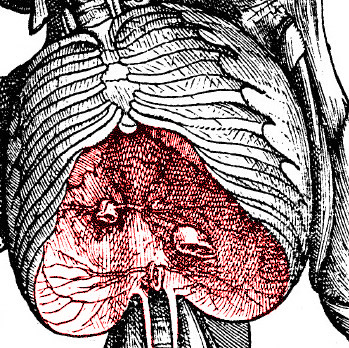
Artist: Andreas Vesalius
Diaphragm in Chest Cavity, From De Humani Corporus, p. 230 (1543)
chest cavity and the abdominal cavity. So it seems fitting that its wounding created a health crises involving both of these normally separate cavities.
Prognosis: Damage to the diaphragm muscle was often deadly because of the movement of the organs. German surgeon Matthias Gottfried Purmann explained that in such wounds "the Intestines will be drawn upward into the Chest, hinder the necessary Motions of the Heart, and inevitably disturb Respiration; so that the Patient may in a manner be suffocated and dye without Remedy"1. This observation is repeated by French surgeon Ambroise Paré who explains that "it sometimes happens by the Vehemency of breathing, that the stomach and guts [intestines] are drawn through the wound into the capacity of the Chest; which thing I observed in two [cases]."2
Symptoms: Both of the above surgical authors agree with Celsus' that one of the symptoms of this problem is 'oppression of the breath'. They also note the patient experiences sharp pain, although they do not specifically point to the spine like Celsus does. However, they each add other symptoms not suggested by Celsus. Both Paré and Purmann specifically mention delirium. Purmann chalks this up to "by excessive Pains and Torments in the nervous parts"3. Paré suggests this is caused "by reason of the sympathy of the Nerves ...which are spread over the midriff"4. Purmann adds "but it generally happens, that such Patients dye in Convulsions"5, a symptom not mentioned by Paré or Celsus. Paré adds two other symptoms, "a weight or heaviness in that place [the midriff]" and a cough.6
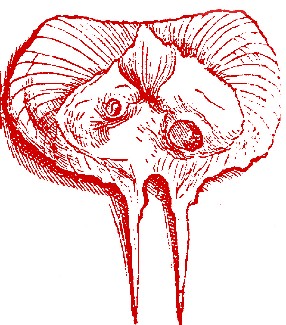
Artist: Andreas Vesalius
Diaphragm Removed, De Humani Corporus, p. 230 (1543)
Cure: Patient with wounded diaphragms didn't always die immediately, possibly due to the gradual movement of the organs which occurred as a result of the wound. Paré discussed a case involving a mason who received a wound to the diaphragm muscle who died three days later. In an autopsy, he discovered that the man's stomach had been "drawn into the Chest, through the wound which was scarse an inch broad. But the stomach was full of wind, but had little humidity in it."7
In another case, Paré told of a soldier shot by a musket bullet which passed "through the fleshy part of the midriff, went out at the space between the fifth and sixth bastard ribs [the ribs attached below the sternum]"8. While he was able to heal the external wound, "a pain of the guts like to the colick [a blockage in the excretory organs] took him, especially in the Evenings, and on the night; for which cause he durst not sup but very sparingly"9. The man died eight months after receiving the wound. Upon opening the body, Paré found "a great portion of the colick gut [intestines] swelled with much wind gotten into the Chest, though the wound of the Diaphragma, for all it was so small that you could scarse put your little finger in thereat."10
1 Matthias Gottfried Purmann, Churgia Curiosa, 1706, p. 116; 2 Ambroise Paré, The Workes of that Famous Chirurgion Ambrose Parey, 1649, pp. 296-7; 3 Purmann, p. 116; 4 Paré, p. 196; 5 Purmann, p. 116; 6 Paré, p. 296; 7,8,9,10 Paré, p. 297
Wounds of the Internal Organs - The Liver
The symptoms of a wounded liver are these: there is a great effusion of blood under the right side of the præcordia [upper middle part of the abdomen]; the præcordia are drawn backward towards the spine; there is a pleasure in lying upon the belly; there are prickings and pains reaching as far as the clavicle [collarbone] and the broad bone of the shoulder, that is joined to it: to these there is sometimes added also a bilious vomiting.” (Aulus Cornelius Celsus, Of Medicine in Eight Books, 1756, p. 274)
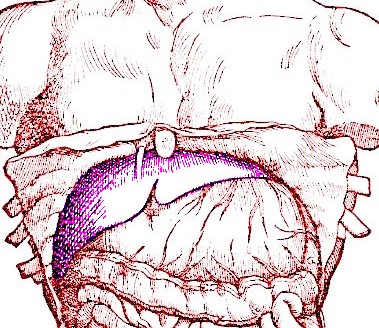
Artist: Andreas Vesalius
Liver in Abdomen Cavity, From De Humani Corporus, p. 561 (1543)
Prognosis: Prognosis for liver wounds was mixed. Ambroise Paré advises that "wounds of the liver are deadly, for this part is the work-horse of the blood, wherefore necessary for life"1. Matthias Gottfried Purmann concurs, up to a point. He says that wounds of the liver which "penetrate into the Substance of it, are generally mortal, because you cannot reach them with Medicines or Stypticks [medicines to stop bleeding], but if they happen in an extreme Part of the Liver ...they may be cured, as might be confirmed in several Examples"2. A wound was usually considered non-lethal when "there runs but little Blood out of the Wound, and no dangerous Symptoms attend it."3
The liver receives blood from two sources: the vena porta or hepatic portal vein - which carries blood into the liver which has been enriched with nutrients from the digestive tract - and the hepatic artery - which brings oxygenated arterial blood to it. After the blood has been processed by the liver, it is sent to the heart through the vena cava. Both Paré and Purmann note that wounds of the liver are often deadly when these hepatic portal and vena cava veins are damaged. Paré explains that when they are cut, there is "a great flux of blood not only inwardly,
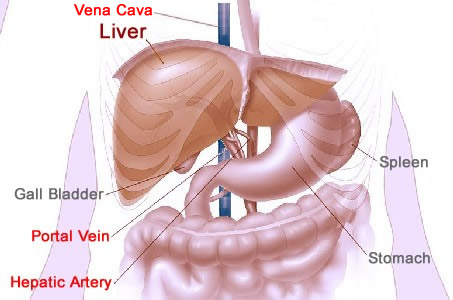
Liver, Veins, Artery and Nearby Organs, Based on National Cancer Inst. Image
but also outwardly, and consequently a dissipation of the spirits and strength."4 Richard Wiseman adds that when the hepatic artery is cut, "the Patient expires with it [the wound]."5
Symptoms: Every one of the period authors who list symptoms of wounds of the liver agree with Celsus that there is a great deal of bleeding at the wound site except for some of them which are non-lethal.6 Wiseman gives more detail, explaining that "If the [hepatic] Artery be wounded, the blood is florid [bright red], and bursts impetuously forth"7. Like Celsus, both Paré and James Cooke mention the patient's preference for lying on their stomach.8 Cooke also repeats Celsus' comments about the position of the wound, noting "'tis on the right side, [and] the sides draw towards the Spine"9. Purmann agrees that the patient vomits up "both Blood and Gall [bile] together"10 and Paré says that the patient vomits choler.11 Choler or yellow bile is one of four bodily humors which were all initially produced by the liver. (This is likely the same thing Purmann calls gall.) Paré and Cooke cover the last of Celsus' mentioned symptoms, with Paré noting that "a pricking pain reaches even to the sword-like gristle
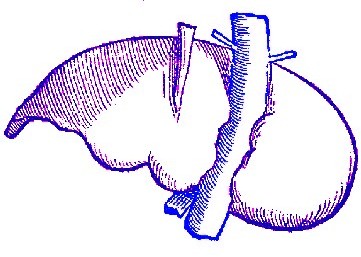
Artist: Andreas Vesalius
Liver, From De Humani Corporus, p. 571 (1543)
[xiphoid process located at the end of the sternum]"12. Cooke takes it further, saying there is a "pricking pain up to the Neck"13.
A couple of the surgeons discuss a symptom not mentioned by Celsus. Purmann says the patient will be "voiding great Quantities of the same Matter [blood and bile] by Stool and Urine; by which you must necessarily discern how difficult the Cure must be."14 James Cooke doesn't mention bile, only calling for blood in the stool and urine.15 However, Cooke adds a symptom no one else mentions, a 'wan' or pale countenance.16
Cure: Richard Wiseman suggests a treatment for "Wounds of the Liver, Spleen, and other Viscera... much after the same manner by Internals."17 He explains that such wounds ought to be kept open (which is contrary to what most surgeons prescribe for general wounds of the abdomen) to allow for dressing the wound as well as for the discharge of 'matter'. He then recommends applying a poultice made of "far. hord. [barley meal] fabar. [bean meal] flor. ros. rub. [red rose petals] coct. cum hydromel [cooked with mead]."18
1 Ambroise Paré, The Workes of that Famous Chirurgion Ambrose Parey, 1649, pp. 296-7; 2,3 Matthias Gottfried Purmann, Churgia Curiosa, 1706, p. 117; 4 Paré, p. 302; 5 Richard Wiseman, Of Wounds, Severall Chirurgicall Treatises, 1686, p. 432; 6 See Paré, p. 302, Purmann, p. 117, Wiseman, p. 432 and James Cooke, Mellificium Chirurgiæ: Or, The Marrow of Chiururgery, 1693, p. 134; 7 Wiseman, p. 432; 8 See Paré, p. 301 and Cooke, p. 134; 9 Cooke, p. 134; 10 Purmann, p. 117; 11,12 Paré, p. 301; 13 Cooke, p. 134; 14 Purmann, p. 117; 15,16 Cooke, p. 134; 17,18 Wiseman, p. 372
Wounds of the Internal Organs - The Kidneys
"When the kidneys are wounded, the pain reaches to the groin and testicles; the urine is made with difficulty; and it is either bloody, or grumous [lumpy or clotted] blood is voided.” (Aulus Cornelius Celsus, Of Medicine in Eight Books, 1756, p. 274)
Prognosis: Matthias Gottfried Purmann states that these wounds are
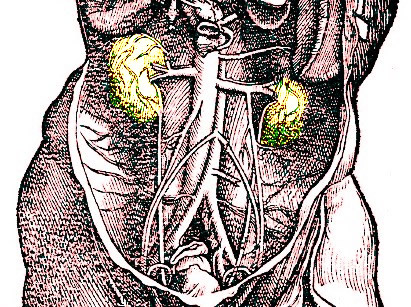
Artist: Andreas Vesalius
Kidneys in Torso Without Digestive Organs, De Humani Corporus (1543)
dangerous and deadly: Dangerous if they enter into the Fleshy parts of them called Parenchyma [the functional parts of the kidney]; but Mortal, if they are wounded in the Middle of their Substance, for thereby they are uncapable of performing their Offices, which are so necessary in Extracting and Separating the Saline and Watry particle of the Blood, and sending them through the Ureters in to the Bladder.1
Military surgeon James Cooke says these wounds are not mortal when they pass into the cavity of the kidney, although after such wounds there "follows an Ulcer that wastes the whole Kidney; yet the party may continue many years."2 He also says that if the Parenchyma is wounded the wound can sometimes still be cured, although with difficulty.
Symptoms: For detecting wounds of the kidneys, Richard Wiseman and Ambroise Paré basically repeat the symptoms mentioned by Celsus.3
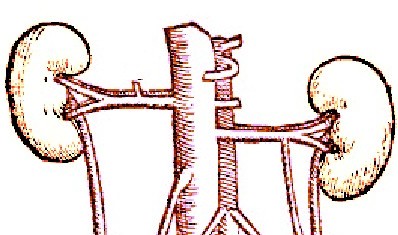
Artist: Andreas Vesalius
Kidneys and Their Connections, From De Humani Corporus, p. 577 (1543)
Cooke adds thirst to the list of symptoms and notes that when wounds to the kidney are superficial that "Blood flows out [of the wound], and Urine is suppressed."4 If the cavity of the kidney is wounded, "Blood flows out with the Urine."5 Purmann says "the running out of a simple and pure blood from the Wound" in the area of the kidneys is a sign that the Parenchyma is wounded.6
Cure: Both Cooke and Wiseman recommend medicines to heal those wounds of the kidney which can be cured. Cooke lists two medicines. First he advises "Inwardly use Troch. Gordon[ius]. [a lozenge containing containing 23 herbal ingredients said to be good for the kidneys] de Carab. [troches of amber - used to stop hemorrhages and the spitting up of blood] de Terr. Sigil. Bol. [troches of Lemnian Earth, also used to stop hemorrhages and spitting blood] Tereb. [turpentine, used to cleanse and heal] and Wound Drinks."7 Wound drinks are vulnerary drinks, given orally, often containing wine.8
Cooke also suggests a pill which he advises is "of great use of Wounds and Ulcers of the Kidneys, and Bladder". This recipe for this pill is:
Photo: Wiki User 4028mdk09
Winter Cherry (Physalis Alkekengi)
Rx. Oss. Human. Calcin. [burnt human bones, astringent and able to stop bleeding] {3 drams} Cretæ vulg. [common chalk, drying and astringent] Gips. Ust. [burnt gypsum, drying and able to stop bleeding] {of each 1 dram} Troch. Alkekeng. [Troches of Winter Cherries, said to be cleansing and diuretic] and {3 drams} Tereb. Vinet. [Venetian turpentine, said to be diuretic] parum coct. q.s. [cooked for a little while, as required] M. f. Pil. magnitudine pisi minor [make into a pill the size of a pea] & respergantur pul. [and sprinkle it with] Liquirit [ licorice].9
The first several ingredients are clearly to stop the wound from bleeding while the last two appear to be there to purge the kidneys.
Richard Wiseman's medicinal recommendation is different from Cooke's in that it is to be injected directly into the wound. He suggests that the medicines used should be of "an abstersive [cleansing and purging] and drying quality"10, which are the same properties recommended by Cooke. Wiseman lists a variety of medicines which will work in this capacity:
...[such] as rad consoled. [comfrey root] irid. [iris root] aristoloch. rot. [round aristolochia root] Also myrtill. cand. [white myrtles] equin. [horsetail - equisetum] plantag[o]. balaust. [pomegranate, probably the flower]11
He goes on to explain how the medicines chosen can be prepared and applied:
Decoct these in aq. chalybeat. [mineral spring water] adding afterwards some Red wine and syr. de ros. sicc. [syrup of dried roses] thereto. Then dress up the Wound with a Digestive ex terebinth [of turpentine] cum integr. ovo. [with an egg] with a little terra sigill. [sealed earth] thus. [frankincense] and Mastich, and embrocate with ol. hyperici [oil of St. John's wort]; applying empl. diachalcith. [plaster of diachalcitheos] malaxt [mixed] with ol. ros. [oil of roses] or a Cataplasm ex far. hord. [of barley meal] fabar. [bean meal] & orobi [probably vetch meal] decocted in Oxymel [honey], and made up with a new-laid Egg and ol. ros.12
1 Matthias Gottfried Purmann, Churgia Curiosa, 1706, p. 119; 2 James Cooke, Mellificium Chirurgiæ: Or, The Marrow of Chiururgery, 1693, p. 135; 3 Richard Wiseman, Of Wounds, Severall Chirurgicall Treatises, 1686, p. 432 & Ambroise Paré, The Workes of that Famous Chirurgion Ambrose Parey, 1649, pp. 302; 4,5 Cooke, p. 134; 6 Purmann, p. 119; 7 Cooke, p. 135; 8 For several such wound drinks see Felix Wartz, The Surgeons Guid: Or Military and Domestique Surgery, 1658. p. 330-4; 9 Cooke, p. 135-6; 10,11,12 Wiseman, p. 433
Wounds of the Internal Organs - The Spleen
"But when the spleen is wounded, black blood issues out from the left side; the præcordia [upper middle part of the abdomen] and stomach on the same side grow hard; a great thirst ensues; and a pain strikes up to the clavicle [collar bone], as when the liver is wounded." (Aulus Cornelius Celsus, Of Medicine in Eight Books, 1756, p. 274)
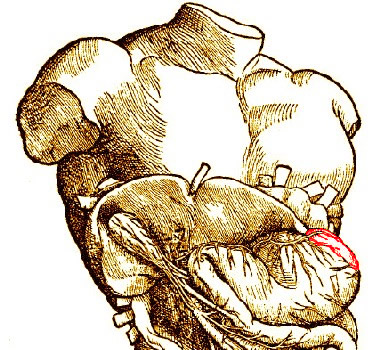
Artist: Andraes Vesalis
Location of Spleen in Body, From De Humani Corporus, p. 566 (1543)
Prognosis: German surgeon Matthias Gottfried Purmann says, "Wounds in the Spleen, if they happen in the Substance of it, are dangerous and deadly; but if the Wound is not very deep, you need not despair of the Cure."1 Military surgeon James Cooke agrees, stating that "if the Vessels be hurt, [the wound is] mortal, if not, [it is] curable."2
Symptoms: The surgeons who discuss the symptoms accompanying a wound of the spleen generally agree with Celsus. Richard Wiseman, Ambroise Paré, Purmann and Cooke all state that black blood flows out of the wound.3 Purmann goes into greater detail on this point, explaining, "at first Blood intermixed with Chyle [a milky fluid consisting of fat droplets and lymph] runs out at the Wound, and afterwards is followed by a thick black Humour, which in a manner looks like Lye [a liquid obtained by leaching ashes] made of Red Wine."4
Like Celsus, Wiseman and Cooke state that wounds of the spleen must be on the left side of the body.5 Cooke notes that the stomach becomes hard6, Wiseman says that there "is a tension"7, while Purmann states that the "Spleen swells, [and] the Iltæ or Flanks tumifie [swell, and thus become hard]."8 Purmann, Paré, and Cooke all mention the patient experiencing great thirst.9 Cooke is the only surgeon to mention pain, which he says "reaches to the Neck."10
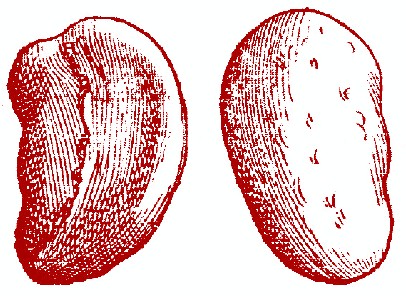
Artist: Andraes Vesalis
Spleen - Bottom and Top, From De Humani Corporus, p. 571 (1543)
Richard Wiseman is the only one to add a symptom not mentioned by Celsus: difficulty of breathing.11
Cure: Wiseman and James Cooke each suggest remedies for wounds to the spleen (which they also note will work for the liver). Wiseman's treatment has already been described under treating wounds of the liver and so will not be repeated here.
Cooke recommends treating the wound with astringent and drying medicines, both of which would help stop bleeding and other flows from the wound.12
He suggests an oral medicine as well: "Troch. De. Spod. [Lozenge of Ivory] in Aq. Plantag. [plantain water] vel Decoct. Ros. rub. [with a decoction of red rose water] add. syr de. ros. sicc. [syrup of dried roses] & Myrtin. [syrup of myrtles] Pul. Ros. rub. [powdered red rose petals] {of each 2 scruples}"13.
Cooke also warns that patient should not be allowed to become constipated. If this occurs, the surgeon is to "use Clysters [enemas] daily"14.
1 Matthias Gottfried Purmann, Churgia Curiosa, 1706, p. 119; 2 James Cooke, Mellificium Chirurgiæ: Or, The Marrow of Chiururgery, 1693, p. 134; 3 Richard Wiseman, Of Wounds, Severall Chirurgicall Treatises, 1686, p. 432, Ambroise Paré, The Workes of that Famous Chirurgion Ambrose Parey, 1649, pp. 302, Purmann, p. 119 & Cooke, p. 134; 4 Purmann, p. 119; 5 Wiseman, p. 432 & Cooke, p. 134; 6 Cooke, p. 134; 7 Wiseman, p. 432; 8 Purmann, p. 119; 9 Purmann, p. 119, Paré, p. 302, & Cooke, p. 134; 10 Cooke, p. 134; 11 Wiseman, p. 432; 12,13,14 Cooke, p. 135

